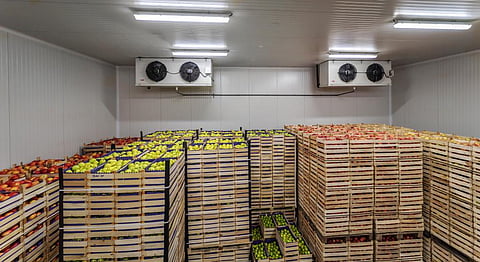

Cold chains in the food processing, packaging, distribution and consumption systems are critical for pulling millions of people out of the cycle of hunger and poverty, according to a new report.
These will also help meet the challenge of feeding an additional two billion people by 2050, said a new report by the United Nations Environment Programme (UNEP) and the Food and Agriculture Organization (FAO).
Sustainable Food Cold Chains: Opportunities, Challenges and the Way Forward was launched November 12, 2022 at the 27th Conference of Parties (COP27) to the UN Framework Convention on Climate Change being held at Sharm El-Sheikh.
The report made a series of recommendations, which included governments and other cold chain stakeholders collaborating to adopt a systems approach and developing National Cooling Action Plans. “This has to be backed with financing, targets as well as implementing and enforcing ambitious energy efficiency standards,” it added.
Of the total food produced for human consumption, an estimated 14 per cent is lost and 17 per cent wasted. This costs the global economy an estimated $936 billion a year.
In 2017, less than half (45 per cent) of the food that required refrigeration worldwide was refrigerated.
The lack of effective refrigeration directly resulted in the loss of 526 million tonnes of food production (12 per cent of the global total). This can feed an estimated one billion people in a world where 811 million people are hungry and three billion are unable to afford a healthy diet.
Food loss and waste also accounted for 8-10 per cent of global greenhouse gas emissions (GHG), according to FAO.
Food loss is particularly high in the developing world, where the available refrigeration capacity is much lower than in developed countries, the report added. Even though the developing countries are home to nearly 80 per cent of the world’s harvested cropland, they refrigerate only around 20 per cent of the perishable food they produce (compared with 60 per cent in developed countries).
Indian farmers incur Rs 92,651 crore per year in post-harvest losses, the primary causes of which are poor storage and transportation facilities.
To reach its full potential, Indian agriculture needs a third revolution — the blue or cool revolution, according to the report.
The blue / cool revolution will help to “build a sustainable cold chain connecting farms to cities, and allow small farmers to develop entrepreneurial agri-businesses serving the growing urban middle class”, according to a paper published by the University of Birmingham in 2017.
A cold chain project was developed in 2016-17 under India’s National Centre for Coldchain Development (NCCD) and executed with the support of Carrier Transicold. The project aimed to supply kinnow fruit (a mandarin hybrid) using precooling and aggregation and helped reduce kinnow losses by 76 per cent, while also lowering emissions.
Carrier said that the Kinnow cold chain increased profitability by up to 23 per cent, reducing post-harvest food loss by 76 per cent and CO₂e emissions by 16 per cent, and opening up exports to 10 countries.
Sustainable food cold chains
Under-developed food cold chains are detrimental for the environment.
To feed the projected global population of 9.7 billion in 2050, food production will have to increase, meaning the need for more food cold chains. As food cold chains require energy, “a business-as-usual approach to development will exacerbate the climate crisis challenges", noted the report.
Climate-friendly cold chains are the need of the hour, as demonstrated at the 31st Meeting of the Parties of the Montreal Protocol in November 2019.
GreenCHILL, a biomass powered refrigeration unit is an example of an alternative refrigeration technique, the report cited. Rather than relying on electricity or fossil fuels, GreenCHILL uses biomass to generate cooling using an adsorption refrigeration technology that uses a solution of water and R-717 (ammonia) as a refrigerant, with zero global warming potential.
As of 2021, New Leaf, the company behind GreenCHILL, had installed 800 tonnes of cold storage space, benefiting more than 5,000 farmers across India, according to the report.
Digitalisation also aids in modernising inventory management in the cold chain, the authors of the report noted.
To reduce spoilage in the milk supply chain, a Kenya-based company Savanna Circuit Technologies developed a solar chilling-in-transit system, with a dairy management system enabled by artificial intelligence, as described in the report.
The system uses solar energy to keep the milk cool during transport from the farm to the collection centre, it noted. “This enables farmers to minimise loss and spoilage and to ensure that revenue can be earned from the milk produced. The technology can also be used by cooperatives and milk processors.”
Reducing journey times by using sophisticated route optimisation technologies is another way to lower emissions from cold chain logistics as well as costs.